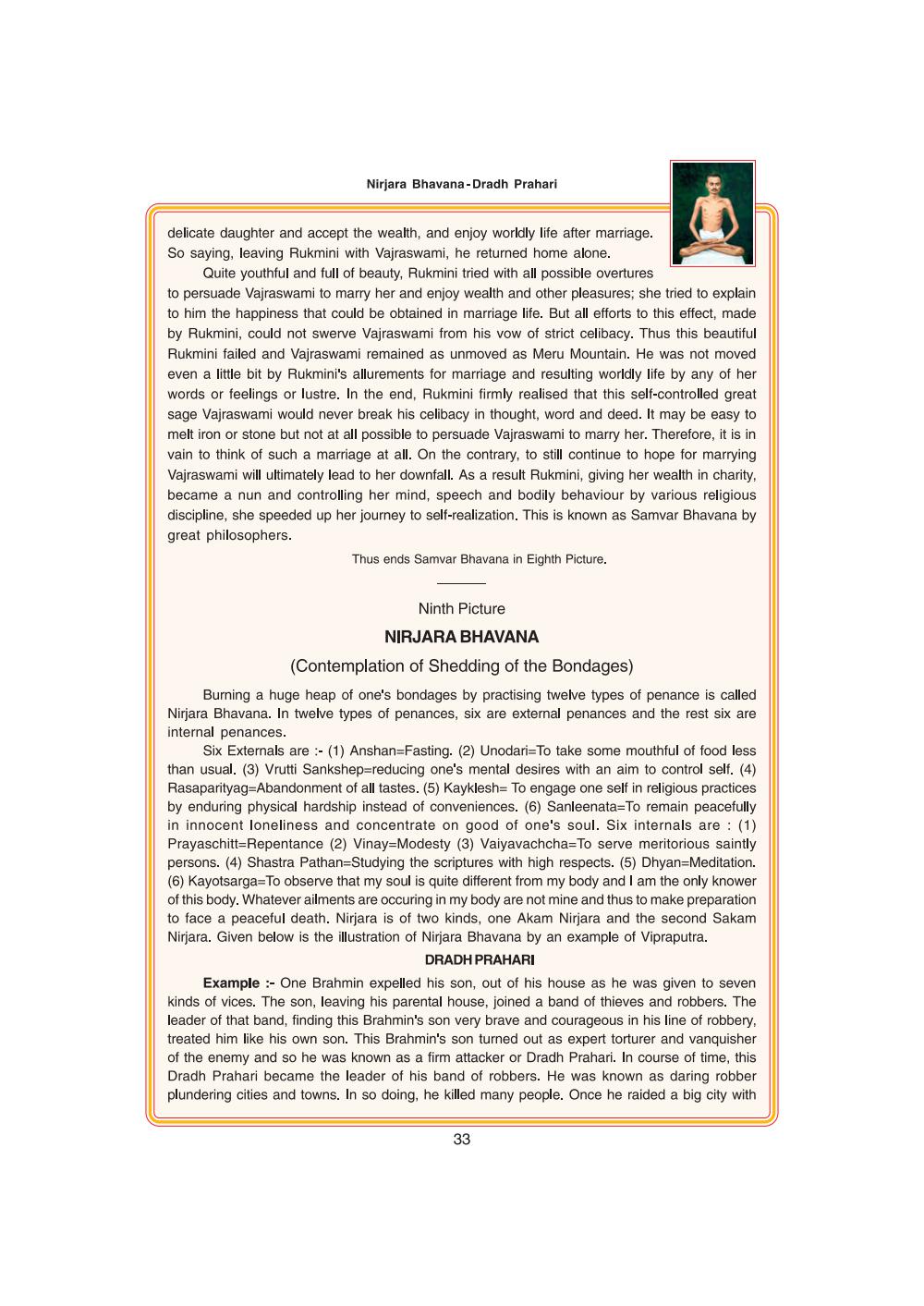________________
Nirjara Bhavana-Dradh Prahari
delicate daughter and accept the wealth, and enjoy worldly life after marriage. So saying, leaving Rukmini with Vajraswami, he returned home alone.
Quite youthful and full of beauty, Rukmini tried with all possible overtures to persuade Vajraswami to marry her and enjoy wealth and other pleasures; she tried to explain to him the happiness that could be obtained in marriage life. But all efforts to this effect, made by Rukmini, could not swerve Vajraswami from his vow of strict celibacy. Thus this beautiful Rukmini failed and Vajraswami remained as unmoved as Meru Mountain. He was not moved even a little bit by Rukmini's allurements for marriage and resulting worldly life by any of her words or feelings or lustre. In the end, Rukmini firmly realised that this self-controlled great sage Vajraswami would never break his celibacy in thought, word and deed. It may be easy to melt iron or stone but not at all possible to persuade Vajraswami to marry her. Therefore, it is in vain to think of such a marriage at all. On the contrary, to still continue to hope for marrying Vajraswami will ultimately lead to her downfall. As a result Rukmini, giving her wealth in charity, became a nun and controlling her mind, speech and bodily behaviour by various religious discipline, she speeded up her journey to self-realization. This is known as Samvar Bhavana by great philosophers.
Thus ends Samvar Bhavana in Eighth Picture.
Ninth Picture
NIRJARA BHAVANA (Contemplation of Shedding of the Bondages) Burning a huge heap of one's bondages by practising twelve types of penance is called Nirjara Bhavana. In twelve types of penances, six are external penances and the rest six are internal penances.
Six Externals are:- (1) Anshan=Fasting. (2) Unodari=To take some mouthful of food less than usual. (3) Vrutti Sankshep=reducing one's mental desires with an aim to control self. (4) Rasaparityag=Abandonment of all tastes. (5) Kayklesh= To engage one self in religious practices by enduring physical hardship instead of conveniences. (6) Sanleenata=To remain peacefully in innocent loneliness and concentrate on good of one's soul. Six internals are: (1) Prayaschitt=Repentance (2) Vinay=Modesty (3) Vaiyavachcha=To serve meritorious saintly persons. (4) Shastra Pathan=Studying the scriptures with high respects. (5) Dhyan=Meditation. (6) Kayotsarga=To observe that my soul is quite different from my body and I am the only knower of this body. Whatever ailments are occuring in my body are not mine and thus to make preparation to face a peaceful death. Nirjara is of two kinds, one Akam Nirjara and the second Sakam Nirjara. Given below is the illustration of Nirjara Bhavana by an example of Vipraputra.
DRADH PRAHARI Example :- One Brahmin expelled his son, out of his house as he was given to seven kinds of vices. The son, leaving his parental house, joined a band of thieves and robbers. The leader of that band, finding this Brahmin's son very brave and courageous in his line of robbery, treated him like his own son. This Brahmin's son turned out as expert torturer and vanquisher of the enemy and so he was known as a firm attacker or Dradh Prahari. In course of time, this Dradh Prahari became the leader of his band of robbers. He was known as daring robber plundering cities and towns. In so doing, he killed many people. Once he raided a big city with
33




